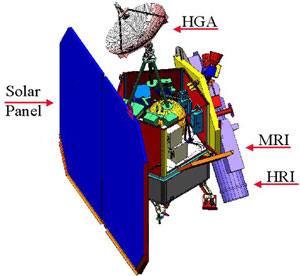As part of Deep Impact's Flight System, the flyby spacecraft is one of two vessels carrying the three science Instruments. Ball Aerospace & Technologies Corp. is designing the spacecraft specifically for the Deep Impact mission.
The flyby spacecraft features a high throughput RAD750 CPU with 1553 data bus-based avionics architecture, and a high stability pointing control system. Spacecraft optical navigation and conventional ground-based navigation will facilitate maneuvering the flyby spacecraft as close as possible to the collision course with comet Tempel 1. When the impactor is released from its union with the flyby spacecraft, the flyby spacecraft will slow itself down and align itself to observe the impact, ejecta, crater development, and crater interior as it passes within 500 km of Tempel 1. It will also receive data from the impactor and transfer it to the Deep Space Network ground receivers.
The flyby spacecraft carries two of the three primary instruments, the High Resolution Instrument (HRI) and the Medium Resolution Instrument (MRI), for imaging, infrared spectroscopy, and optical navigation.

Spacecraft is approx. 3.2m (126") long, 1.7m (68") wide, and 2.3m (92") high.
About the size of a Ford Explorer, the flyby spacecraft is three-axis stabilized and uses a fixed solar array and a small NiH2 battery for its power system. The structure is aluminum and aluminum honeycomb construction. Blankets, surface radiators, finishes, and heaters passively control the temperature. The propulsion system employs a simple blowdown hydrazine design that provides 190 m/s of delta V. The flyby spacecraft mass is 650 kg.
During the encounter phase, a high gain antenna transmits near-real-time images of the impact back to Earth. The flyby spacecraft uses X-band to communicate to Earth and S-band to communicate with the impactor after separation.
Debris shielding is a key part of the flyby S/C design. As the spacecraft passes through the inner coma of the comet it is in danger of being hit by small particles that could damage the control, imaging and communication systems. To minimize this potential damage the spacecraft is rotated before it passes through the inner coma allowing debris shielding to provide complete protection to the flyby spacecraft and instrument elements.

| Payload Power: | 92 W average during engagement |
| Payload Mass: | 370 kg impactor, 90 kg instruments |
| Payload Total Data Volume: | 309 Mbytes |
| Payload Data Downlinked: | 309 Mbytes |
| Pointing Accuracy: | 200 microradian (inst. boresight orientation) |
| Pointing Knowledge: | 65 microradian 3 axes 3-sigma |
| Telecom Band to Earth: | X-band |
| Uplink/Downlink Rates: | 125 bps/175 Kbps (exclusive of Reed-Solomon encoding) |
| Telecom Band to Impactor: | S-band |
| Data Rate to Impactor: | 64 Kbps @ max range (8,700 km) |
| Propulsion/RCS: | 190 m/s divert; 5000 N-s RCS total impulse |











